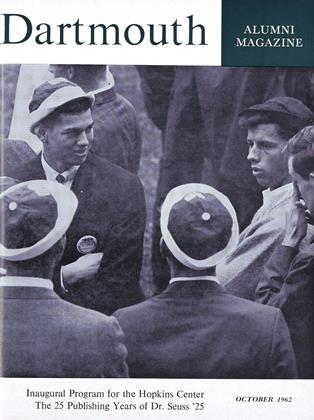By RichardG. Hewlett ’45 and Oscar E. AndersonJr. 766 pp. $5.50.
On the level of personal reminiscence, many can recall the confused excitement surrounding the arrival of the newest family addition, accompanied by frantic and, more often than not, frustrated attempts to document same attempts which were continually being subordinated to the urgency of everyday demands. Thus, miscellaneous drawers and cardboard boxes were stuffed with snapshots, telegrams, notes of congratulation, newspaper clippings and the like, all to be (hopefully) resurrected at some later date and duly recorded into a coherent chronicle of “Johnny’s First Seven Years.”
While the circumstances surrounding the birth of a new governmental program are perhaps less immediate in their personal im- pact, there exists this same initial phenom- enon of documentary disorder, as an awe- some flood of memoranda, letters, at ah, are set aside in the expectation that at some later date they, too, will be interpreted into a meaningful record for future genera- tions.
In a field such as atomic energy, this normal documentary confusion is com- pounded considerably by such additional complications as the secrecy and technical complexity which have characterized this new area of scientific breakthrough. Thus, the historian who attempts to reconstruct order out of chaos here faces a truly diffi- cult, if nonetheless highly significant, chal- lenge.
All of which is by way of a partial ex- planation of why the history of ‘the first seven years’ of the atomic energy program, as set forth in The New World by AEC staff historians Richard G. Hewlett ’45 and Oscar E. Anderson Jr., is a magnificent achievement of more than ordinary propor- tions. As James P. Baxter of Williams Col- lege, the Chairman of the AEC’s Historical Advisory Committee, notes that this is “one of the most important books of the decade” an accolade it deserves for a number of reasons.
To cite but three: this study represents, a superbly organized, complete, and readable summation of one of the truly historic achievements of our time, from the first an- nouncement of the achievement of nuclear fission in Nazi Germany in 1939 through the events leading up to the creation of the Atomic Energy Commission itself in 1946. In addition, here we find a case study of one of the great recurrent problems of human experience man’s initial reaction to the unexpected which is continually being thrust upon him. Hence, important lessons are to be learned from reading about our earliest plans to achieve international control of the atom or about the Churchill-Roosevelt ne- gotiations for the interchange of atomic in- formation or about the newly emerging role of the scientists as active participants in the policy-making process during the bitter de- bates surrounding the issue of “civilian ver- sus military control” of the new Atomic Energy Commission. Finally, the book con- tains a wealth of background material, some of which such as the correspondence of Doctors Bush and Conant has never be- fore been released to the public.
The New World, which was written with the full cooperation of the Atomic Energy Commission, subject to “no other restric- tions than those imposed by national secu- rity,” constitutes Volume I of a series of studies which will make up the “official” history of the atomic energy program. It is to the credit of both the authors and the Commission that this first volume sets such a high standard of achievement against which to measure subsequent studies sched- uled to appear in future years.
 View Full Issue
View Full Issue
More From This Issue
-
 Feature
FeatureDr. Seuss
October 1962 By CLIFFORD L. JORDAN '45 -
 Feature
FeatureThe Vanishing Ability To Write
October 1962 By George O’Connell -
 Cover Story
Cover StoryThe Big Day Draws Near
October 1962 -
 Feature
FeatureTRUSTEES SANCTION A FOURTH TERM
October 1962 -
 Article
ArticleTHE FACULTY
October 1962 By George O’Connell -
 Sports
SportsWITH THE BIG GREEN TEAMS
October 1962 By Dave Orr ’57
Books
-
 Books
BooksFACULTY PUBLICATIONS
April, 1923 -
 Books
BooksALUMNI PUBLICATIONS
November 1923 -
 Books
BooksBriefly Noted
JUNE 1970 By F.H. -
 Books
BooksIT'S EASY TO SKI
January 1937 By Herbert F. West '22 -
 Books
BooksHOW TO ADOPT A CHILD.
JULY 1967 By MICHAEL L. SLIVE '62 -
 Books
BooksINTERNAL STRUCTURE OF GRANITIC PEGMATITES.
December 1949 By Richard E. Stoiber '32

